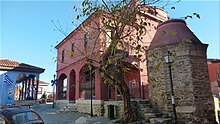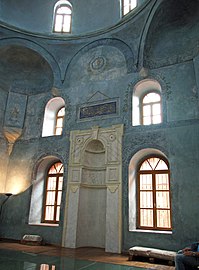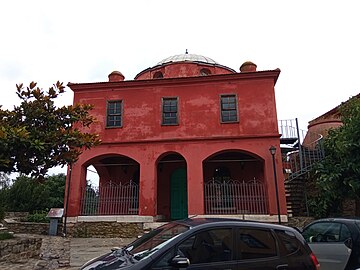| Halil Bey Mosque Τζαμί Χαλίλ Μπέη | |
|---|---|
 | |
| Religion | |
| Affiliation | Islam |
| District | Kavala |
| Province | Eastern Macedonia and Thrace |
| Ecclesiastical or organizational status | Works as a museum |
| Status | Standing |
| Location | |
| Location | Kavala, Greece |
| Municipality | Kavala |
| State | Greece |
 | |
| Geographic coordinates | 40°55′57.11″N 24°24′54.83″E / 40.9325306°N 24.4152306°E / 40.9325306; 24.4152306 |
| Architecture | |
| Type | Mosque |
| Style | Ottoman architecture |
| Funded by | Halil Bey |
| Completed | 16th century |
| Specifications | |
| Dome(s) | 1 |
| Minaret(s) | 1 (destroyed) |
| Materials | Brick and stone |
The Halil Bey Mosque (Greek: Τζαμί Χαλίλ Μπέη, from Turkish: Halil Bey Camii) is a historical Ottoman-era mosque in the town of Kavala, Eastern Macedonia and Thrace, in Greece. It is now a museum open to visitors.
History
It is located in the center of the small peninsula in the port, near the old fortress, and was probably built around the 1530s, which is also when Ibrahim Pasha Mosque is dated. It is the second largest mosque in Kavala, after the aforementioned Ibrahim Pasha. The mosque was built on top of a Byzantine church dedicated to Saint Paraskevi; the remains of the church are now visible through the glass floor of the mosque. It is most likely that the first church was converted into a mosque, and then later the proper mosque building was built on that site, as was common in the areas the Ottomans conquered.
After the Balkan Wars, the mosque along with the greater Kavala region became part of the Kingdom of Greece. At the beginning of the 20th century, the mosque functioned as a girls' school. After the population exchange between Greece and Turkey, Halil Bey mosque and its madrasa (religious school) housed many Greek refugees fleeing Turkey. In the 1930-1940 period, the mosque housed the municipality's philharmonic orchestra and was thus dubbed the "Mosque of Music". To this day, people of Kavala call it "Old Music " (Παλιά Μουσική). The mosque's minaret was torn down in the 1950s.
After a series of restoration works for both the mosque and the madrasa (but not the minaret), it is now open to public and functions as a museum and a venue hall.
Architecture
The mosque was part of a wider complex that also included a madrasa which had eight rooms for students and which has also been preserved in good condition. It is bright red in colour.
Gallery
See also
References
- ^ "Παλιά Μουσική (Τζαμί Χαλίλ Μπέη)" [Old Music (Halil Bey Mosque)]. visitkavala.gr (in Greek). Retrieved November 10, 2022.
- ^ "Τζαμί Χαλίλ Μπέη (Παλιά Μουσική)" [Halil Bey Mosque (Old Music)]. kavalagreece.gr (in Greek). Retrieved November 10, 2022.
External links
 Media related to Halil Bey Mosque at Wikimedia Commons
Media related to Halil Bey Mosque at Wikimedia Commons

